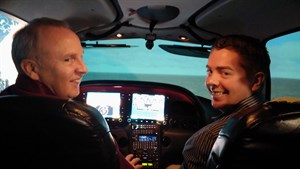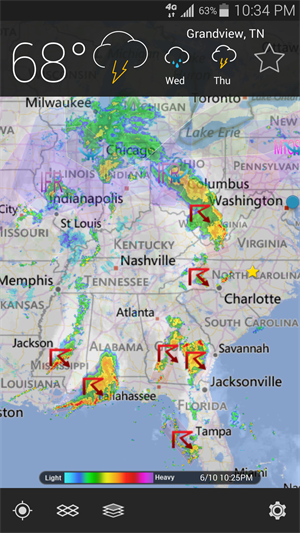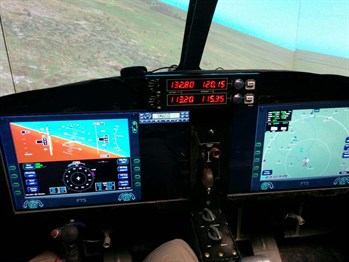 Professor John Valasek in the Department of Aerospace Engineering and Assistant Professor Thomas Ferris in the Department of Industrial and Systems Engineering have been awarded a two-year research project by the Federal Aviation Administration's (FAA) Weather Technology in the Cockpit (WTIC) program titled “General Aviation Weather Alerting.”
Professor John Valasek in the Department of Aerospace Engineering and Assistant Professor Thomas Ferris in the Department of Industrial and Systems Engineering have been awarded a two-year research project by the Federal Aviation Administration's (FAA) Weather Technology in the Cockpit (WTIC) program titled “General Aviation Weather Alerting.”
The project is one of four under the WTIC program that are being researched by member universities of the FAA's Center of Excellence for General Aviation, called the Partnership to Enhance General Aviation Safety and Sustainability (PEGASAS). The six university WTIC team is led by Valasek, with four separate projects being conducted by team members Texas A&M University, Purdue University, The Ohio State University, Western Michigan University, Southern Illinois University, and Kent State University.
 Valasek says that this is a classic problem of the role and proper use of technology.
Valasek says that this is a classic problem of the role and proper use of technology.
“General Aviation (GA) is currently the least safe segment of aviation," he said. "And while there are usually a number of causal factors which combine to cause most accidents, weather is a significant causal factor. Many accidents and incidents that occur in weather are preventable.
"Despite the recent availability of low cost but high-performance hand-held devices with a near real-time weather data capability, such as the Myradar app for Android and Apple devices and the ForeFlight program for iPad, the GA accident rate per 100,000 flight hours are either flat or trending upward within certain segments of the community in recent years. GA pilots are taking these devices with them but are still getting into trouble. So clearly the weather information is there, but there is a problem with how pilots are interpreting it, using it, or not using it. This issue is what the FAA wants to get to the bottom of and fix.”
What this means is refining and demonstrating resolutions to develop specification parameters for Part 91 WTIC Minimum Weather Service (MinWxSvc) that will hopefully reduce the accident rate due to weather.
 The goal of the WTIC General Aviation Weather Alerting research project is to assess the feasibility of developing agile, low latency and intuitive cockpit weather alerts to identify hazardous weather prior to encountering it. The focus is on meteorological (MET) information gaps and shortfalls that contribute to the safety risk that may be mitigated through the use of a more effective weather alerting functions.
The goal of the WTIC General Aviation Weather Alerting research project is to assess the feasibility of developing agile, low latency and intuitive cockpit weather alerts to identify hazardous weather prior to encountering it. The focus is on meteorological (MET) information gaps and shortfalls that contribute to the safety risk that may be mitigated through the use of a more effective weather alerting functions.
The project will be executed in two 12-month phases. In conjunction with researchers Lori J. Brown, Geoff Whitehurst, and William G. Rantz at Western Michigan University, a simulator study is being conducted during Phase I this fall using the Real-Time Engineering Flight Simulator in Valasek’s Vehicle Systems & Control Laboratory (VSCL) in the aerospace engineering department. The study will use a group of 50 GA pilot participants of varying skill levels and experience, ranging from those who have just earned their Private Pilot License to those with thousands of flight hours. The results of the Phase I study will lead to a more extensive flight training device assessment in Phase II using low, medium, and high time pilots throughout 2015 at Western Michigan University.
Human Factors are the heart of this study, according to Ferris.
“This project offers an exciting opportunity to apply human factors engineering design to make a real impact in the quality and timeliness of pilot decisions regarding navigation prior to encountering adverse weather conditions," he said. "In addition to improving access to reliable and useful weather information, the effective design of weather alerts and associated displays – which must capture attention appropriately and be accurately interpreted by pilots while they conduct several other concurrent tasks – is critical to aviation safety, both in current flight operations and as we look ahead to NextGen air transportation systems."
GA pilots are being solicited as participants in the flight simulator study funded by the FAA. The study involves studying the decision-making processes of pilots, and how mental workload affects those processes. Individuals are eligible to participate in this study if they are at least 18 years old and have a valid private pilot’s certificate and have flown in the last six months. Participants will fly two scenarios in the VSCL flight simulator, during which they will verbally enunciate their thought processes as they make flight-related decisions. Mental workload will be assessed through physiological measurement techniques (such as heart rate measures and galvanic skin response) as well as standard subjective workload surveys.
Individuals who have questions, or are interested in learning more about this research, should contact Dr. Thomas Ferris at PilotStudyTAMU@gmail.com or 979-458-2340.
*Although the FAA has sponsored this project, it neither endorses nor rejects the findings of this research. The presentation of this information is in the interest of invoking technical community comment on the results and conclusions of the research.